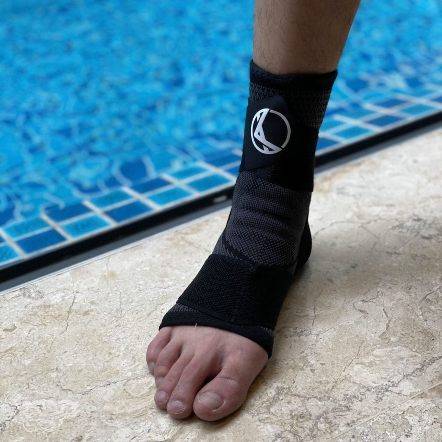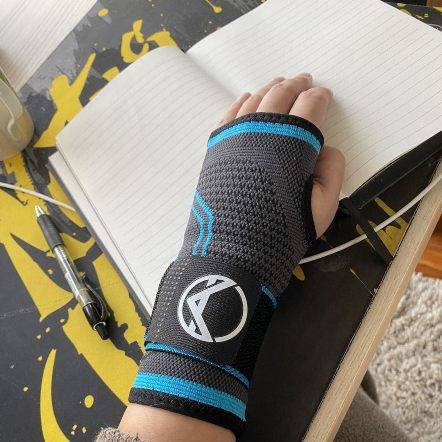
October 25, 2023 | 3 Mins Read
TABLE OF CONTENTS
Experiencing pain in your knee when going upstairs? Various factors can be the culprits behind this discomfort. From overuse injuries such as chondromalacia patella to arthritis and even ligament injuries, understanding the root cause is the key to finding relief. This guide delves deep into the reasons, symptoms, and treatments for knee pain while ascending stairs.

Knee pain while climbing stairs can be due to various reasons. Here are some common causes:
1. Chondromalacia Patellae (Runner's Knee): This condition involves the softening and degeneration of the cartilage beneath the kneecap. Pain arises when the kneecap doesn't glide smoothly over the lower part of the thigh bone, especially during bending motions like stair climbing. This is the most common cause of knee pain when climbing the stairs.
2. Osteoarthritis: This degenerative joint disease involves wear and tear of the knee joint's cartilage. Climbing stairs increases the force on the knees, which can cause pain in arthritic joints. This is another common cause of knee pain when climbing the stairs.
3. Patellar Tendonitis: Often called "jumper's knee," this condition involves inflammation of the patellar tendon, which connects the kneecap to the shinbone. Activities that involve bending the knee, like stair climbing, can exacerbate the pain.
4. Meniscal Tear: The menisci are two pieces of cartilage that act as shock absorbers between the thigh bone and shin bone. Tears can occur with twisting movements and may cause pain when climbing stairs.
5. Bursitis: Inflammation of the bursae, small fluid-filled sacs that cushion the knee joint, can cause pain during activities that involve knee bending.
6. Iliotibial Band Syndrome (ITBS): This is the inflammation of the iliotibial band, a thick band of tissue running from the hip to the outer knee. ITBS can cause pain on the outer side of the knee, especially during activities that involve knee bending.
7. Ligament Injuries: Sprains or tears in the knee ligaments, such as the anterior cruciate ligament (ACL) or medial collateral ligament (MCL), can cause pain and instability during activities like stair climbing.
8. Muscle Imbalances or Weakness: Weakness or imbalances in the muscles that support the knee (like the quadriceps or hamstrings) can affect knee mechanics and lead to pain during activities that stress the knee.
9. Overuse or Strain: Simply overusing or straining the knees can lead to pain, especially in individuals who have suddenly increased their level of physical activity.
10. Other Factors: Being overweight, having flat feet, or not wearing proper footwear can also contribute to knee pain during activities like stair climbing.
If knee pain persists or is associated with other symptoms like swelling, instability, or locking of the knee, it's essential to see a healthcare professional to determine the exact cause and receive appropriate treatment.
Chondromalacia patellae (runner’s knee) and knee osteoarthritis (OA) are the two most common causes of knee pain when climbing up stairs. Differentiating between them can be tricky since both involve the degeneration of knee cartilage. However, there are specific differences in symptoms, demographics, and diagnostic findings. Here are some distinctions:

Experiencing knee pain when climbing stairs can be limiting and concerning. Here are some strategies and treatments you might consider to alleviate or manage the pain:
1. R.I.C.E Method: Especially after a sudden onset or after strenuous activity:
2. Physical Therapy: A physical therapist can assess your knee function and recommend specific exercises to strengthen the muscles around the knee and improve flexibility. This can help relieve pain and prevent future injuries.
3. Anti-inflammatory Medications: Over-the-counter nonsteroidal anti-inflammatory drugs (NSAIDs) like ibuprofen can help reduce pain and inflammation. It's essential to use these as directed and discuss long-term use with a healthcare professional.
4. Weight Management: Carrying excess weight puts additional strain on your knees. Reducing weight through a balanced diet and regular exercise can help decrease knee pain.
5. Supportive Footwear: Shoes that provide proper support can alleviate some of the stress on the knees. Orthotic inserts might also be beneficial, especially for those with flat feet.
6. Knee Supports: Knee braces or sleeves can provide extra support and stability. They can be particularly helpful if there's a known structural issue or if the knee feels unstable.
7. Warm-Up and Stretching: Before engaging in physical activities, make sure to warm up and stretch properly to prevent further strain or injury.
8. Avoid Aggravating Activities: Until your knee feels better, try to avoid activities that cause pain, such as climbing a lot of stairs or heavy lifting.
9. Strength Training: Focusing on strengthening the quadriceps, hamstrings, and calf muscles can help provide better knee support.
10. Joint Supplements: Some people find relief with supplements like glucosamine and chondroitin, which are believed to support joint health. Always consult with a healthcare professional before starting any new supplement.
11. Alternative Therapies: Treatments like acupuncture, massage therapy, or chiropractic care might provide some relief for certain individuals.
12. Surgery: In severe cases or if the cause is structural, surgical intervention might be required. Options could include arthroscopy, realignment, or even total knee replacement, depending on the specific issue and its severity.
If the pain is persistent, worsening, or associated with other concerning symptoms, it's crucial to consult with a healthcare professional. They can provide a definitive diagnosis and suggest suitable treatment options tailored to your situation.
If you're experiencing knee pain when climbing stairs, regardless of the specific diagnosis, wearing a knee sleeve can be beneficial. The sleeve offers support to the knee joint, reduces any minor swelling through its compression, and can help warm the area, which often aids in pain relief.
Additionally, the enhanced proprioception (sense of joint position) provided by a sleeve can potentially improve the coordination and alignment of the joint during movement, such as stair climbing.
However, it's essential to ensure the sleeve fits correctly: not too tight to restrict circulation but snug enough to provide support.
Climbing stairs should be a simple, everyday activity, but for many, it can be a source of discomfort or even dread due to knee pain. By recognizing the potential causes, from common overuse injuries like chondromalacia patella to conditions like arthritis, individuals can take proactive steps toward effective treatment and pain management. Knowledge truly is power in addressing knee pain. With the right guidance, understanding, and interventions, each step up can become easier and more comfortable.
References
Author

Claire Evans worked as the content marketing manager at Koprez. Claire combined a background of writing and editing, marketing, and patient education to best serve consumers, fitness enthusiasts, athletes, and anyone who relies on the Koprez brand for helpful information.
Koprez® Featured Products


"I sprain my wrist super often, so I decided to try out this sleeve. This is game-changing! I've been using it for a while now, and my wrists feel amazing. I haven't gotten in any injuries since using it too. It just makes my wrists feel so supported."
Alexis A.


"Use this for my boxing training. It is a very comfortable brace and does not move out of position during skipping ropes and sparring sessions. I use it while running too. Probably the best brace I've purchased throughout the years. It is very flexible. Makes me look like a pro! :)"
Samuel L.


"I've just got back to running after a couple of years of being plagued by injury. These compressions socks are helping give me peace of mind while I build up my distance again. They are the perfect level of compression, super comfy, and very high quality. Feel great while on a run, and looks great in the orange colour I have!"
Dave R.


"I have a weak ankle, and the Koprez ankle sleeve has been a lifesaver. Wear it every day. Super breathable and comfortable. Like wearing a cool sporty looking sock!"
James F.


"This is the best knee sleeve I've ever tried. It's now a must-have for all my exercises. A few years ago, I had an accident that damaged my knees, but with Koprez I can be active again with no knee pains at all. It's been truly amazing!"
Alex M.


"One of the best purchases I've ever made. It fits your legs all the way from top to bottom, great snug fit, gives you support and definitely helps during rehab and training."
Rafael A.


"I had a minor elbow injury, and Koprez sleeve was super supportive and definitely helped me recover faster. I still use the sleeve to prevent further injury. So far, so good. Very comfortable and does not feel hot at all. Highly recommend!"
Corey B.


"It's really been a game-changer for me. It allows me to exercise a lot longer than I used to. Now my knees don't hurt, and they're not uncomfortable at all."
Mike P.


"Great product!!"
Harold


"I have carpal tunnel, and this brace has helped me work pain-free. Love the materials, and I can feel my wrists slowly getting better, even when I don't wear them!"
Christopher J.


"I wanted to try out these sleeves to improve my squats and deadlift in the gym without worrying about injuring my knees. They stayed up throughout the entire gym session, and my knees feel super supported. Now I can do what I love for years to come. "
Corbin C.